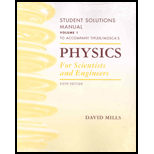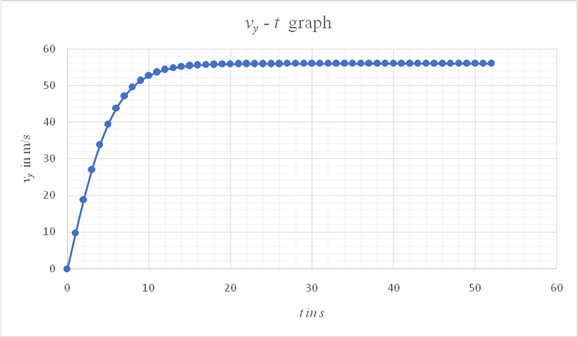
Concept explainers
(a)
To show:The speed of a sky diver, whose acceleration is given by the equation
(a)
Explanation of Solution
Given:
The equation for the acceleration
The expressions for the terminal speed
The speed of the sky diver at time
Calculation:
Rewrite equation (1) using the expression for acceleration
Rearrange the above equation as follows:
Integrate both sides of the equation.
Therefore,
Evaluate the integral
Let
Therefore,
Rewrite equation (5) as shown:
The expression
Therefore, equation (7) takes the form,
Use the identity,
Hence write equation (8) as,
Therefore, equation (4) can be written as ,
Substitute the value of
Apply the initial conditions of the sky diver
Therefore, equation (10) can be written as,
Therefore,
From equations (2)
Therefore, equation (12) can be written as,
Hence,
Conclusion:
Thus, it is proved that the speed of a sky diver, whose acceleration is given by the equation
(b)
To Find:The fraction of the terminal speed is the speed of the sky diver at time
(b)
Answer to Problem 119P
At time
Explanation of Solution
Given:
The equation for the speed of the sky diver
Calculation:
Substitute
Conclusion:
Thus, at time
(c)
To graph:
(c)
Explanation of Solution
Given:
The equation for the speed of the sky diver
Calculation:
In a spread sheet, calculate the values of

Conclusion:
Thus, it can be seen from the graph that the sky diver attains the terminal velocity at around 20 s.
Want to see more full solutions like this?
Chapter 2 Solutions
Physics For Scientists And Engineers Student Solutions Manual, Vol. 1
- On a spacecraft two engines fire for a time of 389 s. One gives the craft an acceleration in the x direction of ax = 3.41 m/s^2, while the other produces an acceleration in the y direction of ay = 7.34 m/s^2. At the end of the firing period, the craft has velocity components of vx = 1860 m/s and vy = 4290 m/s. Find the (a) magnitude and (b) direction of the initial velocity. Express the direction as an angle with respect to the +x axis.arrow_forwardA particle moves along the x-axis with position at time t given by x(t) = e^t cos t for 0<= t <= 2pi. Find each time t, for which the particle is at rest.arrow_forwardIf the effects of atmospheric resistance are accounted for, a freely falling body has an acceleration defined by the equation a = 9.81[1 - v ^2 (10 ^-4)] m/s^2, where v is in m/s and the positive direction is downward. If the body is released from rest at a very high altitude, determine (a) the velocity when t = 5 s, and (b) the body’s terminal or maximum attainable velocity (as t S ).arrow_forward
- A cannon ball is fired with an initial speed of 123 m/s at angle of 60 degrees from the horizontal. Express the initial velocity as a linear combination of its unit vector components. ( m/s) + ( m/s) At the maximum height, the speed of the cannon ball is v = m/s and the magnitude of its acceleration is a = m/s2. The time needed to reach maximum height is t = s. The maximum height reached by the cannon ball is H = m.arrow_forwardFor a short time, the path of the plane in the figure is described by y = (0.001x^2) m. If the plane is rising with a constant velocity of 10 m/s, determine the magnitudes of the velocity and acceleration of the plane when it is at y = 100 m.arrow_forwardAn object is projected upward from ground level at an angle (Theta) and the air resistance is negligible. If the initial velocity, v0, of the object is given in ft/sec and time t is measured in seconds, then the formulas for the object's height h and the horizontal distance traveled (the range) d after t seconds into flight are as follows. h= V0 t sin (Theta) - 16t2 d = tv0 cos (Theta) If (Theta) = 30 (Degrees) and the initial velocity is 140 ft/sec what is the following? (a) The object's maximum height. (b) The object's range.arrow_forward
- A formula for acceleration, a, of a point P moving on a line is a= 6t -6, where s = 0, v = 2 and t = 0. Find the law of motion.arrow_forwardDetermine a time, t > 0, when the transverse acceleration at the point x = 2.00 m is 0.arrow_forwardA force F of magnitude 665 N lies in the line of action AB = 3i - 1j + 1.6k. What is the magnitude of the y-component of the force?arrow_forward
- If an object has a constant x-component of velocity and suddenly experiences an acceleration at an angle of 70° in the x direction, does the x-component of velocity change?arrow_forwardA body of mass 5 kg, projected at different angle from the ground with an initial velocity of 25 m/s, acceleration due to gravity is g = 9.81 m/s^2, what angle of projection that will give the farthest range?arrow_forwardGiven that the velocity of a certain particle varies with displacement according to the equation x'=2a/x^4, find the force as a function of x? NOTE: where x' is the first derivative of displacement vector x.arrow_forward
 Principles of Physics: A Calculus-Based TextPhysicsISBN:9781133104261Author:Raymond A. Serway, John W. JewettPublisher:Cengage Learning
Principles of Physics: A Calculus-Based TextPhysicsISBN:9781133104261Author:Raymond A. Serway, John W. JewettPublisher:Cengage Learning
